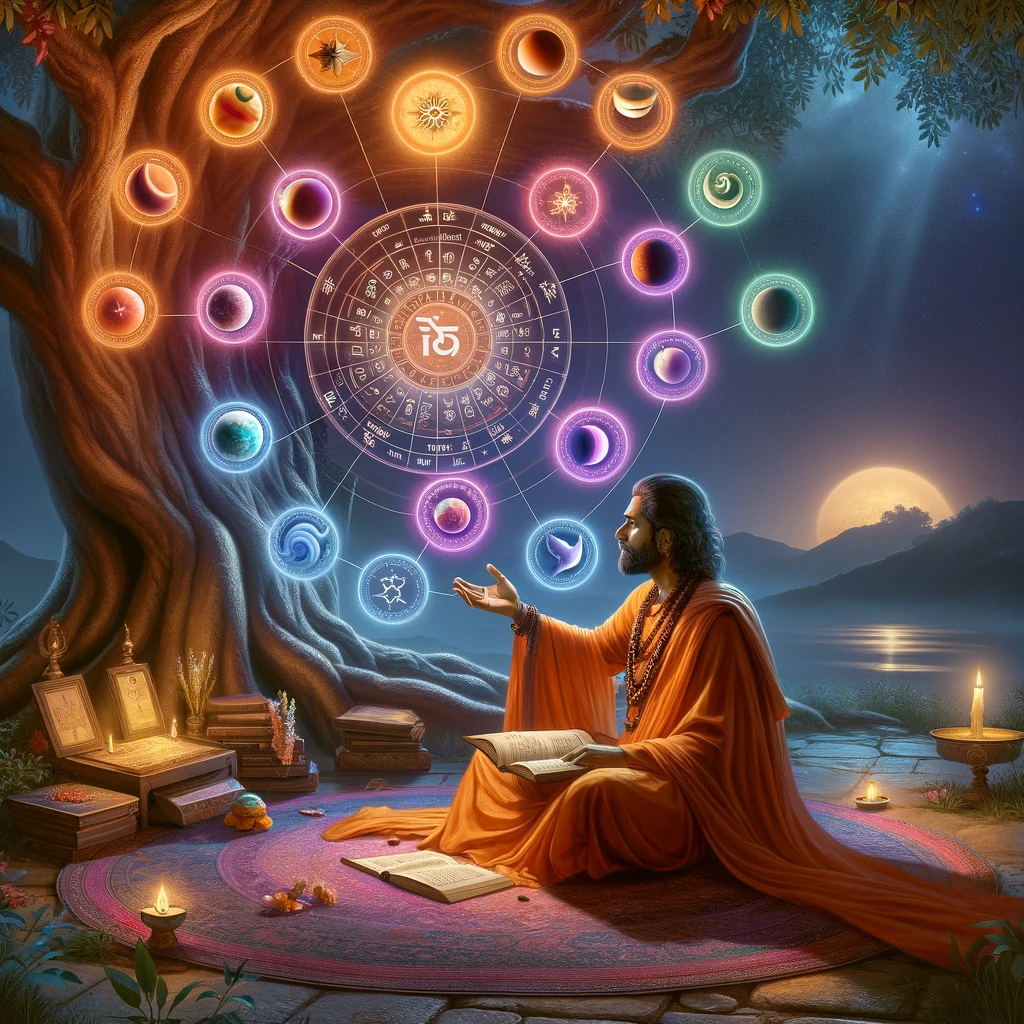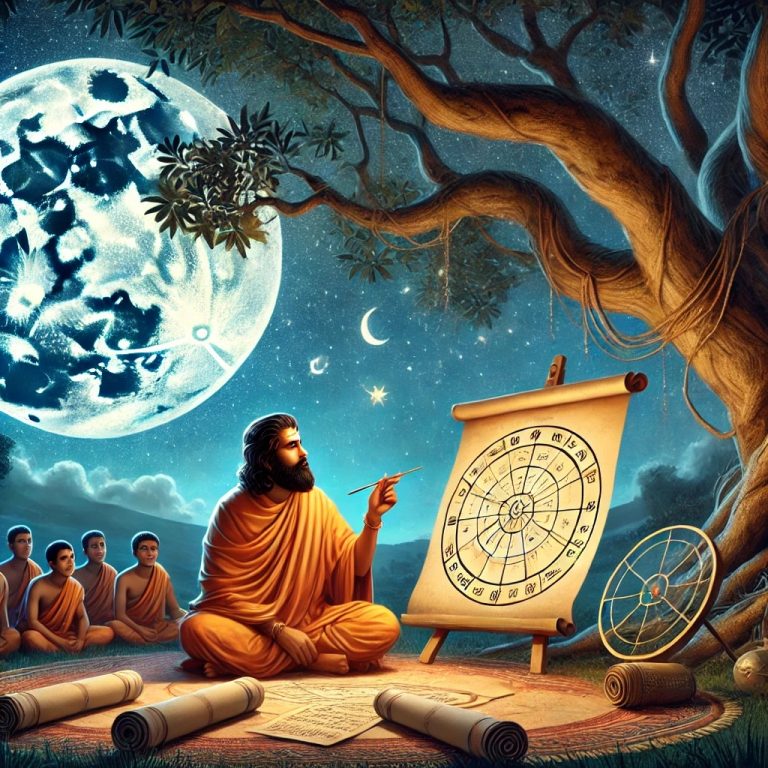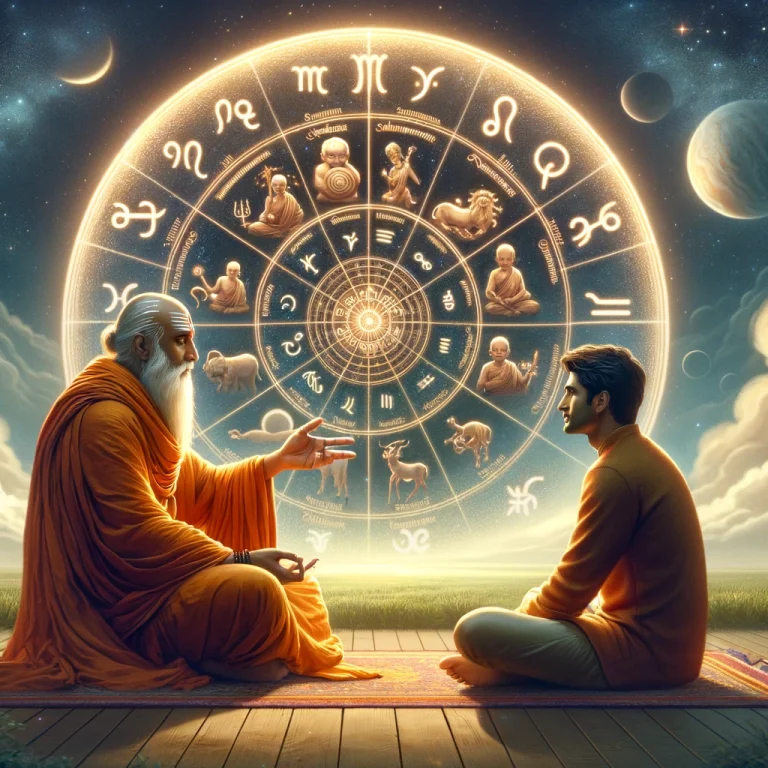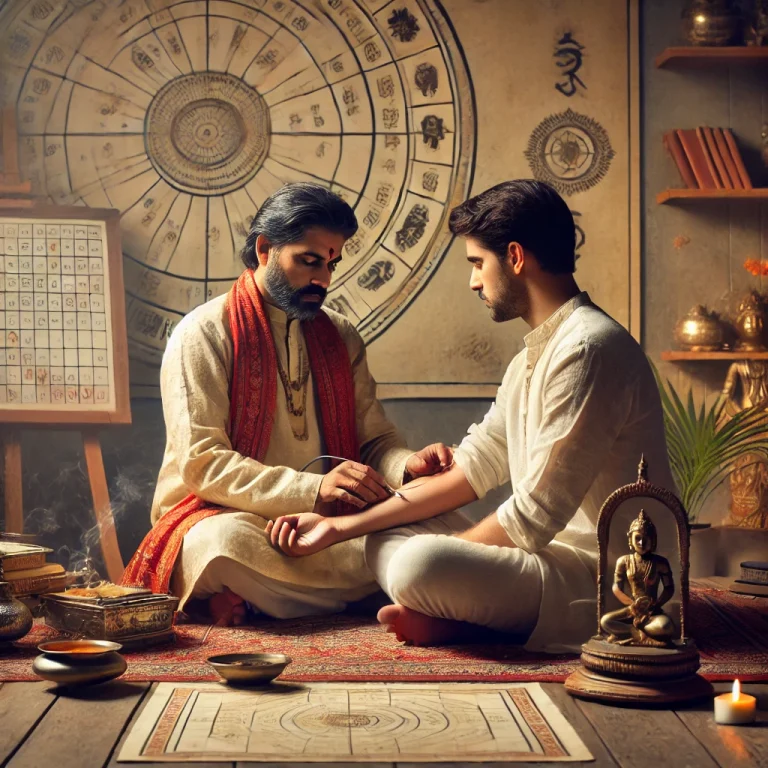Soul’s Journey Through the Planets: From Past Karma to Spiritual Liberation
The purpose of life is one of the most profound questions we all grapple with at some point. From the spiritual perspective, life is a journey, a cycle of learning, growth, and evolution that spans across multiple lifetimes. In Vedic astrology, this cycle of existence and its lessons are deeply influenced by planetary energies, each representing various aspects of the soul’s journey towards liberation, or moksha. Understanding this journey through the movement and influence of celestial bodies offers a roadmap to understanding our past, present, and future, and ultimately guides us toward spiritual liberation.
Table of Contents
ToggleSaturn: The Weight of Past Karma and the Beginning of the Journey
Saturn, often called Shani in Vedic astrology, is the planet of karma. Saturn represents the consequences of our past actions, accumulated across lifetimes, which manifest in this life as challenges, responsibilities, and limitations. In this model of life, Saturn is the initial force that provides us with a physical body—the vehicle for our soul’s journey through the material world.
Saturn’s energy is often seen as harsh, but this is not without reason. It reflects the concept of karmic balance, the need to resolve the effects of actions committed in past lives. The body we are given is not just a random form, but a direct result of our previous actions and desires. This body becomes our instrument to work through karma, and through Saturn, we face the consequences of these actions in the form of obstacles, delays, and suffering. However, these difficulties are not to punish but to teach. Saturn’s role is to impart wisdom through discipline, patience, and endurance.
Saturn’s placement in the birth chart indicates the areas of life where we will face the most significant karmic lessons. It forces us to confront limitations, but through these limitations, we gain maturity and spiritual insight. The purpose of this stage of the journey is to ground the soul in the material world, making us aware of our karma and setting the stage for the spiritual evolution that is to follow.
Mars: The Will to Act and Overcome
Once we are embodied through the force of Saturn, Mars comes into play. Mars represents agni, the fiery energy of action, willpower, and survival instincts. While Saturn reflects the limitations of karma, Mars provides us with the courage, strength, and determination to face those limitations.
Mars is associated with the physical vitality that allows us to navigate the material world and overcome obstacles. It represents the warrior within us, the one who fights for survival, for justice, and for progress. In the context of spiritual evolution, Mars gives us the will to act on the lessons that Saturn has laid before us. This is crucial because, without the drive to confront challenges, there can be no growth. Mars pushes us to take action, to be proactive in fulfilling our dharma (life purpose) and to initiate the process of self-improvement.
However, Mars can also represent impulsiveness and aggression if not balanced. The spiritual lesson of Mars is to harness this energy constructively. When directed properly, Mars becomes the force that helps us conquer our lower instincts and channel our energy toward purposeful action.
Jupiter: The Self and Prana
Jupiter, known as Guru in Vedic astrology, represents the higher self, wisdom, and the breath of life, or prana. After Mars initiates action, Jupiter comes in to guide that action with wisdom and discernment. Where Mars is force, Jupiter is knowledge. Jupiter is associated with spiritual growth, expansion, and the search for meaning.
Jupiter’s energy is deeply connected to prana, the life force that animates the body and mind. Without prana, there can be no life, no consciousness. Prana connects us to the divine, and through breath, we are reminded of the subtle essence that sustains us. In the journey of the soul, Jupiter represents the awareness of a higher purpose. While Mars might lead us to act, Jupiter teaches us why we act.
Jupiter also represents the search for truth and the desire to connect with something greater than the material world. It is through Jupiter’s influence that we begin to cultivate a sense of spirituality, ethics, and philosophy. Jupiter governs our faith, optimism, and the ability to see beyond the limitations imposed by Saturn. In a sense, Jupiter balances the karmic forces by providing hope and a path toward enlightenment.
The Moon: The Mind and Emotional Life
The Moon represents manas, the mind, and the emotional life of an individual. After the soul is given prana by Jupiter, it becomes necessary to develop the mind, which governs perception, thoughts, feelings, and intuition. The Moon’s influence on our life journey is profound because it shapes how we experience reality.
In Vedic astrology, the Moon reflects our emotional nature, our subconscious mind, and how we perceive the world around us. It governs our desires, our fears, and our emotional responses to the challenges that Saturn brings and the actions Mars pushes us toward. The mind is where most of our karma manifests—our attachments, our aversions, and the various mental patterns that define our personal reality.
The spiritual purpose of the Moon is to develop emotional maturity. It teaches us to cultivate peace, compassion, and emotional balance. The Moon also reflects our past-life experiences, and through its energy, we are often drawn to experiences that resonate with unresolved emotions from previous incarnations. On a deeper level, the Moon represents the soul’s memory, and by understanding the Moon’s influence, we gain insight into the subtle emotional forces that shape our lives.
Venus: The Energy of Wealth, Pleasure, and Relationships
After the Moon, Venus comes into play. Venus represents Shukra, the energy of love, beauty, wealth, and relationships. In the material world, Venus governs the pursuit of pleasure and comfort, as well as our interactions with others. Venus teaches us about love and how to find joy in the world.
However, from a spiritual perspective, Venus’s energy has a dual role. While it represents material wealth and the pleasures of life, it also points us toward higher forms of love and beauty. The lessons of Venus revolve around balancing material desires with spiritual aspirations. Venus teaches us to appreciate the material world without becoming attached to it.
In relationships, Venus reflects the lessons of love, partnership, and selflessness. By learning to give and receive love without attachment, we purify our desires and move closer to spiritual love—unconditional, divine love. Venus’s energy can be a source of both fulfillment and distraction. While it provides the joy of life’s experiences, it also tests our ability to transcend those experiences in pursuit of higher truth.
Mercury: The Power of Communication and Profession
After Venus comes Mercury, the planet of intellect, communication, and profession. Mercury governs our ability to think logically, analyze situations, and express ourselves. It is through Mercury’s influence that we develop our skills, learn, and engage in our chosen professions.
On a spiritual level, Mercury represents the intellect’s role in guiding the soul’s journey. It provides the capacity to discern, to make decisions, and to communicate effectively. Professionally, Mercury teaches us the importance of karma yoga—the path of selfless work. By focusing on duty and serving others through our profession, we can use Mercury’s energy to contribute positively to society and work through our karma.
Mercury’s influence is about balance, particularly the balance between the material and spiritual worlds. While it governs our rational mind, it also reminds us that true wisdom transcends intellect. The spiritual lesson of Mercury is to cultivate clear thinking while maintaining openness to higher truths that cannot be explained solely through logic.
The Sun: The Path to Moksha
Finally, after we have moved through the various planets and their influences, we reach the Sun. The Sun represents the Atman, the soul, and is the ultimate goal of life—moksha, or liberation from the cycle of birth and death.
The Sun symbolizes the highest state of consciousness, the realization of the self as one with the divine. In the context of the soul’s journey, the Sun is the guiding light that illuminates the path to enlightenment. Through the Sun, we experience our true nature, free from the limitations of karma, desire, and ego. The Sun’s influence is about self-realization, the understanding that we are not merely the body, mind, or emotions but eternal souls on a journey back to the source.
Moksha is the final destination, and the Sun’s energy is the beacon that draws us toward it. The purpose of life, then, is to move through the material world, learn its lessons, and ultimately transcend it, returning to a state of pure consciousness.
Ketu and Rahu: Two Paths to Moksha
Ketu and Rahu, the lunar nodes, represent two distinct pathways to moksha. Ketu bypasses the materialistic aspects of life, particularly the mind (Moon), and leads directly to the Sun, or liberation. Ketu represents detachment and the spiritual impulse to renounce the world and seek the divine directly. Those influenced by Ketu often experience a life of spiritual focus, often bypassing worldly concerns.
On the other hand, Rahu represents the soul’s attachment to the material world. Rahu pulls the individual through a long journey that involves engagement with Jupiter (self), Venus (wealth), and Mercury (profession). Rahu represents the karmic desires that keep the soul entangled in the material world. However, after a long journey of indulgence and learning, Rahu eventually leads the soul back to the Sun, to moksha, but through a more extended and complicated route. In this sense, Ketu represents a direct, spiritual path, while Rahu represents the soul’s journey through materialism before it finally seeks liberation.
What to do for a balanced life and ultimately to achieve liberation
To follow the astrological sequence of planetary influences in a balanced way and ultimately achieve liberation (moksha), one needs to harmonize the energies represented by each planet, integrating their lessons while avoiding excesses or imbalances. Each planet provides specific energies and experiences that are essential for spiritual growth, and they are all interconnected. By following this sequence consciously, we can align our life with higher spiritual principles while engaging with the material world in a balanced way. Here’s a step-by-step approach to follow this “vicious” cycle and achieve a balanced life that leads to moksha:
Saturn (Shani): Understanding and Resolving Past Karma
Saturn represents our past karma, limitations, and the burdens we carry. Its primary lessons are patience, discipline, endurance, and humility. Without Saturn’s grounding influence, spiritual progress cannot begin.
Balanced Approach:
- Accept Your Karma: Saturn demands that we accept responsibility for our past actions and understand that the challenges we face are not punishments but opportunities to grow. Reflect on your life circumstances and see them as a result of your past actions, both in this life and previous ones.
- Discipline and Duty: Saturn’s energy requires you to perform your duties with responsibility. This involves committing to your obligations—whether they are family, work, or spiritual practices—with patience and perseverance. Spiritual discipline, like daily meditation, prayer, or selfless service, helps neutralize karmic debt.
- Embrace Simplicity: Saturn favors austerity and simplicity. Avoid excessive attachment to material possessions, and practice humility. Simplicity in thoughts, actions, and lifestyle leads to clarity and deeper spiritual growth.
Mars (Mangal): Harnessing Energy and Willpower
Mars represents energy, willpower, and action. It helps you confront obstacles and push through challenges with courage and determination.
Balanced Approach:
- Controlled Action: Use Mars’ energy to take decisive and focused action, but avoid aggression or impulsiveness. Be mindful that your actions are aligned with dharma (right conduct), rather than ego-driven desires. This means acting with purpose, rather than reacting emotionally or out of anger.
- Overcome Fear: Mars helps you face fears and obstacles head-on. Channel your inner warrior and use this energy to overcome not just external challenges but also inner battles like fear, laziness, and procrastination.
- Physical and Mental Strength: Keep your body and mind strong. Mars governs physical vitality, so engage in physical activity, yoga, or any practice that strengthens your willpower and focus.
Jupiter (Guru): Expanding Wisdom and Spiritual Knowledge
Jupiter represents higher wisdom, spiritual growth, and the prana (life force) that sustains you. It helps expand your consciousness and understand the deeper purpose of life.
Balanced Approach:
- Seek Knowledge and Truth: Engage in learning and expand your understanding of both spiritual and worldly knowledge. This may include studying sacred texts, philosophy, or engaging with a spiritual teacher (Guru).
- Align with Dharma: Jupiter is the planet of morality and ethics. Make sure your actions are in alignment with higher principles of truth, compassion, and integrity. Acting in accordance with your dharma brings peace and harmony into your life.
- Spiritual Practice: Regular meditation, prayer, or breathwork (like pranayama) will help you maintain a connection with the divine energy, or prana. This sustains your spiritual vitality and allows you to move through life with a sense of purpose and faith.
Moon (Chandra): Cultivating Emotional Awareness and Mindfulness
The Moon governs the mind and emotions, shaping how you perceive and react to life’s experiences. The Moon’s lesson is to develop emotional maturity and balance, helping you transcend mental turbulence.
Balanced Approach:
- Emotional Awareness: Become aware of your emotions and subconscious patterns. The Moon reflects your past-life experiences, and many emotional responses are tied to unresolved karma. Practice mindfulness and meditation to observe your emotions without attachment.
- Mental Stability: A calm mind is essential for spiritual progress. Practice calming techniques like meditation, journaling, or spending time in nature to soothe emotional fluctuations. Avoid letting external circumstances overly affect your mental state.
- Nurture Your Inner Self: Just as the Moon reflects the Sun’s light, cultivate self-reflection to become aware of your higher nature. Align your emotional life with your spiritual goals by practicing self-compassion, forgiveness, and empathy.
Venus (Shukra): Balancing Material Desires and Higher Love
Venus represents pleasure, wealth, love, and relationships. It shows the importance of balancing material enjoyment with spiritual detachment.
Balanced Approach:
- Enjoy without Attachment: Venus teaches you to appreciate beauty, love, and pleasure, but not to become attached to them. Enjoy the material world, but remember that these experiences are transient. Cultivate gratitude for the pleasures in life while staying grounded in your spiritual purpose.
- Higher Love: Venus’s energy, when refined, teaches you about higher forms of love—unconditional, selfless, and divine love. Learn to express love in your relationships without expecting anything in return, as this leads to spiritual growth.
- Wealth with Responsibility: Use your wealth and resources wisely. Venus teaches us to accumulate wealth ethically and to use it for the greater good, not just personal indulgence. Practice generosity and charity as a way to detach from materialism.
Mercury (Budh): Intellectual Clarity and Professional Life
Mercury governs intellect, communication, and profession. Its role is to help you think clearly and express yourself effectively in both your personal and professional life.
Balanced Approach:
- Clarity of Thought: Mercury’s influence helps you discern the difference between illusion and truth. Cultivate mental sharpness and clear communication, both in worldly and spiritual matters. Engage in activities that challenge your mind, like learning new skills or engaging in debates.
- Service through Profession: Mercury represents karma yoga—the path of selfless action. Align your profession with your higher purpose. Approach your work as a form of service to others, and see it as an opportunity to work through karma while contributing positively to society.
- Balance Logic and Intuition: While Mercury governs logical thinking, remember to balance it with intuitive understanding, which comes from deeper spiritual insight (linked to Jupiter). Use your intellect as a tool to guide your spiritual path, not to dominate it.
The Sun (Surya): Self-Realization and the Path to Moksha
The Sun represents the Atman (soul) and moksha (liberation). It symbolizes the highest spiritual goal—realization of the self and unity with the divine.
Balanced Approach:
- Self-Realization: The ultimate purpose of life is to realize that your true nature is beyond the body, mind, and ego. The Sun represents your higher self, the soul that is eternal. Cultivate practices like meditation, self-inquiry, and detachment from ego-based desires to connect with your true self.
- Live with Purpose: The Sun is the source of all life and vitality, and in the same way, you must live with a sense of higher purpose. Align your life with spiritual goals, serving others, and embodying qualities like integrity, truth, and leadership.
- Seek Liberation: Spiritual liberation is the release from the cycle of birth and death (samsara). Through consistent spiritual practice, selfless service, and inner reflection, move towards moksha by detaching from the material world and recognizing your divine nature.
Ketu and Rahu: Navigating the Spiritual and Material Pathways
- Ketu’s Direct Path to Moksha: Ketu represents spiritual detachment and leads directly to liberation, bypassing the material world. If you feel drawn to a more renunciant or inward spiritual path, focus on practices that cultivate deep meditation, introspection, and detachment from material desires. This path often involves bypassing worldly achievements and focusing entirely on spiritual awakening.
- Rahu’s Long Path Through Materiality: Rahu, on the other hand, pulls you toward material experiences—wealth, pleasure, and power—before eventually leading to liberation. If you are engaged in the material world, ensure that you learn the spiritual lessons it offers and avoid getting lost in illusion. Rahu’s path is long and winding but can still lead to moksha if you balance material success with spiritual wisdom.
Conclusion
To achieve moksha while leading a balanced life, you must integrate the lessons of all the planets. Engage with the material world through Saturn, Mars, Venus, and Mercury, but always in alignment with Jupiter’s higher wisdom, the Moon’s emotional awareness, and the Sun’s spiritual purpose. Ultimately, balance is key. By learning from each planet’s energies and experiences, you transform your karma and move toward liberation, transcending the material world and realizing your eternal, divine nature.





